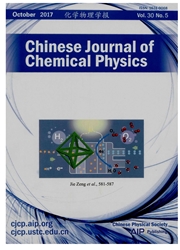

 中文摘要:
中文摘要:
在 260, 271, 284,和 287 nm 刺激之上的 benzaldehyde 的 ultrafast 动力学被 femtosecond 泵探查 time-of-flight 团 spectrometry 学习了。一个双性人指数的腐烂部件模型被使用适合 benzaldehyde 离子和碎片离子的短暂侧面。在 S2 起源,部件的第一腐烂被归因于内部变换到 S1 状态的高震动的层次。第一个部件的一生与增加震动的精力减少了,由于震动的层次的高密度的影响。第二腐烂被分到其一生是大约 600 fs 的 S1 的震动的松驰。在 287 nm 刺激之上,第一腐烂变得超短波(~ 56 fs ) 它从 S1 为 intersystem 十字被带去 T2,当第二个腐烂部件被归因于震动的松驰时。碎片短暂的泵探查也在 284 nm 泵与不同探查紧张被学习。
 英文摘要:
英文摘要:
The ultrafast dynamics of benzaldehyde upon 260, 271, 284, and 287 nm excitations have been studied by femtosecond pinup-probe time-of-flight mass spectrometry. A bi-exponential decay component model was applied to fit the transient profiles of benzaldehyde ions and fragment ions. At the S2 origin, the first decay of the component was attributed to the internal conversion to the high vibrational levels of S1 state. Lifetimes of the first component decreased with increasing vibrational energy, due to the influence of high density of the vibrational levels. The second decay was assigned to the vibrational relaxation of the S1 whose lifetime was about 600 fs. Upon 287 nm excitation, the first decay became ultra-short (-56 fs) which was taken for the intersystem cross from S1 to T2, while the second decay component was attributed to the vibrational relaxation. The pump-probe transient of fragment was also studied with the different probe intensity at 284 nm pump.
 同期刊论文项目
同期刊论文项目
 同项目期刊论文
同项目期刊论文
 Three-peak Autler-Townes splitting in the photoelectron spectrum of Li2 molecules caused by femtosec
Three-peak Autler-Townes splitting in the photoelectron spectrum of Li2 molecules caused by femtosec Field modulation of Rydberg-state populations of NO studied by femtosecond time-resolved photoelectr
Field modulation of Rydberg-state populations of NO studied by femtosecond time-resolved photoelectr Theoretical prediction of stable structures of lithiosilicon species based on planar double, triple,
Theoretical prediction of stable structures of lithiosilicon species based on planar double, triple, Steering population transfer via continuum structure of the Li2 molecule with ultrashort laser pulse
Steering population transfer via continuum structure of the Li2 molecule with ultrashort laser pulse 期刊信息
期刊信息
